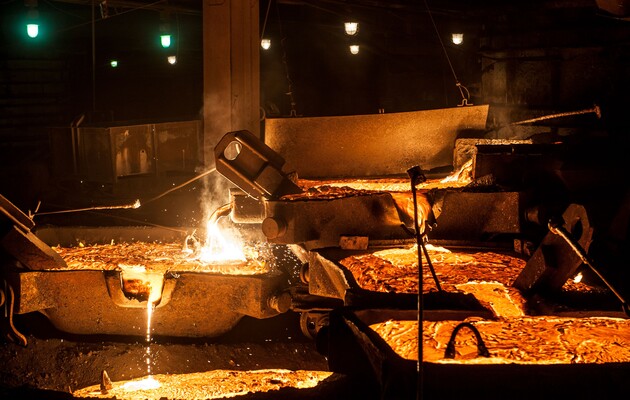Titanium War: Ukraine Can And Should Replace Russia In This Market

On September 25, the US Department of Commerce announced the decision to include five more Russian companies in the sanctions list, including the largest titanium producer VSMPO-Avisma and 23 other companies from different countries. The American government notes that these enterprises help the Russian military-industrial complex (MIC), which is engaged in the production of missiles and drones.
The expansion of international sanctions on Russia’s titanium industry can significantly exceed the effect of existing sanctions and, together with them, cause a lot of damage to the enemy’s military industry. But the dependence of the West on the import of titanium products from the Russian Federation until recently restrained Ukraine’s allies from decisive sanctions.
According to experts, the Russian economy is generally stagnating under the influence of sanctions. At the same time, against this background, its militarization and the formation of import substitution are taking place, to some extent – successfully.
One of the highest priorities of the West’s sanctions policy is to restrict the supply to the Russian Federation of radio electronics, necessary for the production of drones and missiles. However, by the end of 2022, Russian missile production, after a brief slowdown at the beginning of the sanctions, began to develop again. Not the last role in this process is played by the established mechanism of sanctions circumvention.
“Friends” and a number of factors make it impossible to control the sanctions policy. Some of the electronics needed by the aggressor continue to be imported into Russia legally under the guise of components for the manufacture of household appliances. Various smuggling channels are used for components whose supply requires eliminating any traces of movement. Processors, microcircuits, printed circuit boards, due to their small size, can be easily smuggled across the border in large quantities.
Meanwhile, aviation and missile production is not only electronics, but also engines, special materials for missile bodies, and chemistry for explosives and fuel. Sanction policy regarding high-tech products needs to be strengthened in other areas.
And titanium can be such a direction.
Titanium makes up 50% of the weight of the Su-35 fighter, 70% of the X-101 missile and 60% of the Caliber missile. Controlling and limiting the supply of titanium raw materials is many times easier than tracking the movement of microcircuits and chips on the black market and thousands of home appliance factories that use the electronics that Russia needs.
What you need to know about the titanium industry of the Russian Federation
Despite all the wealth of subsoil and natural resources, Russia is critically dependent on titanium raw materials. Exact data on titanium ore reserves of the Russian Federation are classified, but it is publicly declared that they are second only to China in terms of volume. At the same time, due to the low level of development of deposits and the low quality of titanium ores, Russia has an acute shortage of enriched raw materials. The aggressor has neither the time nor the opportunity to develop deposits and establish mining and processing chains as Calibers are needed every day for Ukrainian cities.
How does Russia manage not only to manufacture missiles and fighter jets, but also to maintain a leading position among exporters of titanium products to the West? For decades, Russian enterprises covered the need for raw materials thanks to supplies from Ukraine, engaged in processing and manufacturing final products with high added value and exported them to the West. At the same time, Ukrainian processing facilities remained idle and stopped over time, the titanium industry of Ukraine turned into a raw material appendage of Russian industry. The country was losing the opportunity to earn billions in profits thanks to the production of final products with high added value.
Meanwhile, a powerful titanium industry has been created in Russia, which includes partner, service and subsidiary enterprises that ensure its smooth functioning. This extensive system directly or indirectly includes, in particular, enterprises in foreign jurisdictions. It covers the entire chain of work of the titanium industry: the purchase of raw materials from abroad, its extraction in limited quantities and staged processing in Russia, the manufacture and sale of final titanium products abroad, including to Western giants of the aviation and space industry. But this entire powerful processing complex was built in the absolute majority on imported raw materials.
At the same time, until now, the majority of enterprises in the Russian titanium industry and service organizations, as well as their managers, have remained outside the sanctions not only of Western countries, but also of Ukraine.
The implementation of a coherent sanctions policy to stop the flow of titanium ore raw materials to the Russian Federation, as well as the spread of international sanctions on all components of the titanium industry of the Russian economy, will be the addition to the current sanctions that will have a decisive impact on the military industry of the aggressor.
“Titanium ticket” for Ukraine
Ukraine’s reserves are estimated differently, but according to most estimates, they are the largest in Europe. According to the report of the US Geological Survey (USGS) for 2022, in terms of titanium ore reserves, Ukraine is in the world top ten with 5.9 million tons of ilmenite reserves and 2.5 million tons of Ukrainian rutile reserves. This is the most modest assessment, with which some Ukrainian specialists do not agree. At the same time, there is a unanimous opinion that these explored and developed reserves are enough to take the leading place in the world market of titanium products.
The bottleneck in the global production of metal titanium is the limited free reserves of capacities for the creation of titanium sponge. It is impossible to bypass this stage in the technology of metal titanium production at the current level of development of metallurgy in the foreseeable future. Titanium sponge is produced only in seven countries, including Ukraine.
No one in the world currently plans to design and build factories for the production of titanium sponge (except perhaps China) due to their extremely negative impact on the environment, the health of workers and the population of nearby cities, as well as the potential for explosiveness and the probability of man-made accidents.
And therefore, under current conditions, no powerful and authoritative titanium company in any civilized country will be able to obtain permission from state control bodies and the population of the surrounding territories to build new factories for the production of spongy titanium.
Therefore, in the foreseeable future, the entire increase in the volume of titanium sponge production is possible only within the limits of the available capacities. This is an important point, if we consider that the only enterprise for the production of titanium sponge in Europe, the Zaporizhzhya Titanium Magnesium Plant, with a design capacity of 20,000 tons, in the pre-war period produced up to 12,000 tons of sponge titanium per year.
For decades, Ukraine was essentially the only country in the world that had a full production cycle of titanium metal products — from world-class resources for mining and processing ore to machining titanium ingots, including the production of sheet metal, bars, and pipe products.
These factors create a real potential opportunity for Ukraine to replace Russia in the supply of metal titanium products for Western enterprises.
The restoration of the titanium industry of the Ukrainian economy will create a reliable source of supply of titanium products to Western countries and eliminate their dependence on supplies from unfriendly countries.
The article was prepared based on the results of the research of the NGO Center for Analytical Studies and Countering Hybrid Threats “Identification and Analysis of Corrosive Investments in the Ukrainian Economy as an Element of Hybrid War. Part 2”.
Please select it with the mouse and press Ctrl+Enter or Submit a bug












 Login with Google
Login with Google